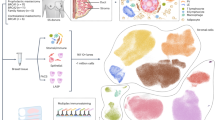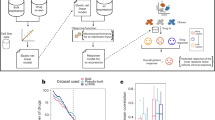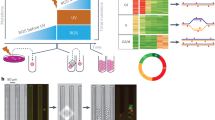Abstract
What happens in early, still undetectable human malignancies is unknown because direct observations are impractical. Here we present and validate a 'Big Bang' model, whereby tumors grow predominantly as a single expansion producing numerous intermixed subclones that are not subject to stringent selection and where both public (clonal) and most detectable private (subclonal) alterations arise early during growth. Genomic profiling of 349 individual glands from 15 colorectal tumors showed an absence of selective sweeps, uniformly high intratumoral heterogeneity (ITH) and subclone mixing in distant regions, as postulated by our model. We also verified the prediction that most detectable ITH originates from early private alterations and not from later clonal expansions, thus exposing the profile of the primordial tumor. Moreover, some tumors appear 'born to be bad', with subclone mixing indicative of early malignant potential. This new model provides a quantitative framework to interpret tumor growth dynamics and the origins of ITH, with important clinical implications.
This is a preview of subscription content, access via your institution
Access options
Subscribe to this journal
Receive 12 print issues and online access
$209.00 per year
only $17.42 per issue
Buy this article
- Purchase on Springer Link
- Instant access to full article PDF
Prices may be subject to local taxes which are calculated during checkout





Similar content being viewed by others
Accession codes
References
Greaves, M. & Maley, C.C. Clonal evolution in cancer. Nature 481, 306–313 (2012).
Vogelstein, B. et al. Cancer genome landscapes. Science 339, 1546–1558 (2013).
Basanta, D. & Anderson, A.R.A. Exploiting ecological principles to better understand cancer progression and treatment. Interface Focus 3, 20130020 (2013).
Fearon, E.R. & Vogelstein, B. A genetic model for colorectal tumorigenesis. Cell 61, 759–767 (1990).
Siegmund, K.D. et al. Inferring clonal expansion and cancer stem cell dynamics from DNA methylation patterns in colorectal cancers. Proc. Natl. Acad. Sci. USA 106, 4828–4833 (2009).
Navin, N. et al. Inferring tumor progression from genomic heterogeneity. Genome Res. 20, 68–80 (2010).
Gerlinger, M. et al. Intratumor heterogeneity and branched evolution revealed by multiregion sequencing. N. Engl. J. Med. 366, 883–892 (2012).
Sottoriva, A. et al. Intratumor heterogeneity in human glioblastoma reflects cancer evolutionary dynamics. Proc. Natl. Acad. Sci. USA 110, 4009–4014 (2013).
Sottoriva, A., Spiteri, I., Shibata, D., Curtis, C. & Tavaré, S. Single-molecule genomic data delineate patient-specific tumor profiles and cancer stem cell organization. Cancer Res. 73, 41–49 (2013).
Korolev, K.S., Avlund, M., Hallatschek, O. & Nelson, D.R. Genetic demixing and evolution in linear stepping stone models. Rev. Mod. Phys. 82, 1691–1718 (2010).
Korolev, K.S. et al. Selective sweeps in growing microbial colonies. Phys. Biol. 9, 026008 (2012).
McFarland, C.D., Korolev, K.S., Kryukov, G.V., Sunyaev, S.R. & Mirny, L.A. Impact of deleterious passenger mutations on cancer progression. Proc. Natl. Acad. Sci. USA 110, 2910–2915 (2013).
Humphries, A. et al. Lineage tracing reveals multipotent stem cells maintain human adenomas and the pattern of clonal expansion in tumor evolution. Proc. Natl. Acad. Sci. USA 110, E2490–E2499 (2013).
Garcia, S.B., Park, H.S., Novelli, M. & Wright, N.A. Field cancerization, clonality, and epithelial stem cells: the spread of mutated clones in epithelial sheets. J. Pathol. 187, 61–81 (1999).
Wright, N.A. & Poulsom, R. Top down or bottom up? Competing management structures in the morphogenesis of colorectal neoplasms. Gut 51, 306–308 (2002).
Schwarz, R.F. et al. Phylogenetic quantification of intra-tumour heterogeneity. PLoS Comput. Biol. 10, e1003535 (2014).
Barker, N. et al. Crypt stem cells as the cells-of-origin of intestinal cancer. Nature 457, 608–611 (2009).
Anderson, K. et al. Genetic variegation of clonal architecture and propagating cells in leukaemia. Nature 469, 356–361 (2011).
Park, S.Y., Gönen, M., Kim, H.J., Michor, F. & Polyak, K. Cellular and genetic diversity in the progression of in situ human breast carcinomas to an invasive phenotype. J. Clin. Invest. 120, 636–644 (2010).
Thirlwell, C. et al. Clonality assessment and clonal ordering of individual neoplastic crypts shows polyclonality of colorectal adenomas. Gastroenterology 138, 1441–1454 (2010).
Sprouffske, K., Pepper, J.W. & Maley, C.C. Accurate reconstruction of the temporal order of mutations in neoplastic progression. Cancer Prev. Res. (Phila.) 4, 1135–1144 (2011).
Lopez-Garcia, C., Klein, A.M., Simons, B.D. & Winton, D.J. Intestinal stem cell replacement follows a pattern of neutral drift. Science 330, 822–825 (2010).
Comen, E., Norton, L. & Massagué, J. Clinical implications of cancer self-seeding. Nat. Rev. Clin. Oncol. 8, 369–377 (2011).
Cancer Genome Atlas Network. Comprehensive molecular characterization of human colon and rectal cancer. Nature 487, 330–337 (2012).
Nowak, M.A. Evolutionary Dynamics (Harvard University Press, 2006).
Lengauer, C., Kinzler, K.W. & Vogelstein, B. Genetic instability in colorectal cancers. Nature 386, 623–627 (1997).
Nowak, M.A. et al. The role of chromosomal instability in tumor initiation. Proc. Natl. Acad. Sci. USA 99, 16226–16231 (2002).
S Datta, R., Gutteridge, A., Swanton, C., Maley, C.C. & Graham, T.A. Modelling the evolution of genetic instability during tumour progression. Evol. Appl. 6, 20–33 (2013).
Almendro, V. et al. Inference of tumor evolution during chemotherapy by computational modeling and in situ analysis of genetic and phenotypic cellular diversity. Cell Rep. 6, 514–527 (2014).
Yatabe, Y., Tavaré, S. & Shibata, D. Investigating stem cells in human colon by using methylation patterns. Proc. Natl. Acad. Sci. USA 98, 10839–10844 (2001).
Sottoriva, A. & Tavaré, S. in Proc. COMPSTAT 2010 (eds. Saporta, G. & Lechevallier, Y.) 57–66 (Springer Physica-Verlag HD, 2010).
Marjoram, P. & Tavaré, S. Modern computational approaches for analysing molecular genetic variation data. Nat. Rev. Genet. 7, 759–770 (2006).
Cleary, A.S., Leonard, T.L., Gestl, S.A. & Gunther, E.J. Tumour cell heterogeneity maintained by cooperating subclones in Wnt-driven mammary cancers. Nature 508, 113–117 (2014).
Marusyk, A. et al. Non-cell-autonomous driving of tumour growth supports sub-clonal heterogeneity. Nature 514, 54–58 (2014).
Luebeck, E.G. & Moolgavkar, S.H. Multistage carcinogenesis and the incidence of colorectal cancer. Proc. Natl. Acad. Sci. USA 99, 15095–15100 (2002).
Lawrence, M.S. et al. Mutational heterogeneity in cancer and the search for new cancer-associated genes. Nature 499, 214–218 (2013).
Siegmund, K.D., Marjoram, P., Tavaré, S. & Shibata, D. Many colorectal cancers are 'flat' clonal expansions. Cell Cycle 8, 2187–2193 (2009).
Kostadinov, R.L. et al. NSAIDs modulate clonal evolution in Barrett's esophagus. PLoS Genet. 9, e1003553 (2013).
Burrell, R.A. et al. The causes and consequences of genetic heterogeneity in cancer evolution. Nature 501, 338–345 (2013).
Baca, S.C. et al. Punctuated evolution of prostate cancer genomes. Cell 153, 666–677 (2013).
Heng, H.H.Q. et al. Stochastic cancer progression driven by non-clonal chromosome aberrations. J. Cell. Physiol. 208, 461–472 (2006).
Rosenberg, S.M. Evolving responsively: adaptive mutation. Nat. Rev. Genet. 2, 504–515 (2001).
Stephens, P.J. et al. Massive genomic rearrangement acquired in a single catastrophic event during cancer development. Cell 144, 27–40 (2011).
Sottoriva, A. et al. Cancer stem cell tumor model reveals invasive morphology and increased phenotypical heterogeneity. Cancer Res. 70, 46–56 (2010).
Clevers, H. The cancer stem cell: premises, promises and challenges. Nat. Med. 17, 313–319 (2011).
Bernards, R. & Weinberg, R.A. Metastasis genes: a progression puzzle. Nature 418, 823 (2002).
Ramaswamy, S., Ross, K.N., Lander, E.S. & Golub, T.R. A molecular signature of metastasis in primary solid tumors. Nat. Genet. 33, 49–54 (2003).
Diaz, L.A. Jr. et al. The molecular evolution of acquired resistance to targeted EGFR blockade in colorectal cancers. Nature 486, 537–540 (2012).
Staaf, J. et al. Normalization of Illumina Infinium whole-genome SNP data improves copy number estimates and allelic intensity ratios. BMC Bioinformatics 9, 409 (2008).
Olshen, A.B. et al. Parent-specific copy number in paired tumor-normal studies using circular binary segmentation. Bioinformatics 27, 2038–2046 (2011).
Curtis, C. et al. The genomic and transcriptomic architecture of 2,000 breast tumours reveals novel subgroups. Nature 486, 346–352 (2012).
Cibulskis, K. et al. Sensitive detection of somatic point mutations in impure and heterogeneous cancer samples. Nat. Biotechnol. 31, 213–219 (2013).
Wolff, A.C. et al. American Society of Clinical Oncology/College of American Pathologists guideline recommendations for human epidermal growth factor receptor 2 testing in breast cancer. J. Clin. Oncol. 25, 118–145 (2007).
Bozic, I. et al. Accumulation of driver and passenger mutations during tumor progression. Proc. Natl. Acad. Sci. USA 107, 18545–18550 (2010).
Michor, F., Iwasa, Y. & Nowak, M.A. Dynamics of cancer progression. Nat. Rev. Cancer 4, 197–205 (2004).
Acknowledgements
The authors would like to acknowledge the technical assistance of R. Guzman. This project was supported in part by an award to C.C. from the V Foundation for Cancer Research and by award numbers P30CA014089, R21CA149990 and R21CA151139 from the National Cancer Institute. The content is solely the responsibility of the authors and does not necessarily represent the official views of the National Cancer Institute or the US National Institutes of Health. M.F.P. was supported by a grant from the California Institute for Regenerative Medicine (CIRM).
Author information
Authors and Affiliations
Contributions
A.S., D.S. and C.C. designed the study, interpreted the data and constructed the model. D.S. provided clinical specimens. Z.M. and D.S. processed the specimens. Z.M. generated sequencing data. P.M. and K.S. contributed data. H.K. and M.F.P. performed FISH. A.S. developed and implemented the computational framework. A.S., M.P.S. and J.Z. analyzed the data with oversight from C.C. A.S., D.S. and C.C. wrote the manuscript with input from T.A.G. D.S. and C.C. oversaw the study. All authors read and approved the final manuscript.
Corresponding authors
Ethics declarations
Competing interests
The authors declare no competing financial interests.
Supplementary information
Supplementary Information
Supplementary Figures 1–14 and Supplementary Tables 1 and 2. (PDF 5927 kb)
Supplementary Table 3
Supplementary Table 3 (XLSX 52 kb)
Rights and permissions
About this article
Cite this article
Sottoriva, A., Kang, H., Ma, Z. et al. A Big Bang model of human colorectal tumor growth. Nat Genet 47, 209–216 (2015). https://doi.org/10.1038/ng.3214
Received:
Accepted:
Published:
Issue Date:
DOI: https://doi.org/10.1038/ng.3214
This article is cited by
-
The reckoning of chromosomal instability: past, present, future
Chromosome Research (2024)
-
Advances in functional lipid nanoparticles: from drug delivery platforms to clinical applications
3 Biotech (2024)
-
Tumour Growth Mechanisms Determine Effectiveness of Adaptive Therapy in Glandular Tumours
Interdisciplinary Sciences: Computational Life Sciences (2024)
-
Tumor-derived cell-free DNA and circulating tumor cells: partners or rivals in metastasis formation?
Clinical and Experimental Medicine (2024)
-
Mesenchymal stem cells can prevent or promote the progression of colon cancer based on their timing of administration
Journal of Translational Medicine (2023)



